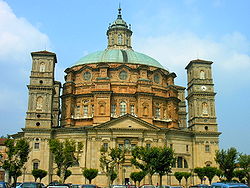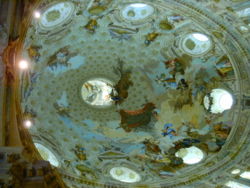
Sanctuary of Vicoforte
Encyclopedia


Comune
In Italy, the comune is the basic administrative division, and may be properly approximated in casual speech by the English word township or municipality.-Importance and function:...
of Vicoforte
Vicoforte
Vicoforte is a comune in the Province of Cuneo in Italy. It is located in Val Corsaglia above sea level, 32 km east of Cuneo and 6 km from Mondovì....
, province of Cuneo
Province of Cuneo
ayr is a province in the southwest of the Piedmont region of Italy. To the west it borders on the French region of Provence-Alpes-Côte d'Azur ....
, Piedmont
Piedmont
Piedmont is one of the 20 regions of Italy. It has an area of 25,402 square kilometres and a population of about 4.4 million. The capital of Piedmont is Turin. The main local language is Piedmontese. Occitan is also spoken by a minority in the Occitan Valleys situated in the Provinces of...
, northern Italy
Italy
Italy , officially the Italian Republic languages]] under the European Charter for Regional or Minority Languages. In each of these, Italy's official name is as follows:;;;;;;;;), is a unitary parliamentary republic in South-Central Europe. To the north it borders France, Switzerland, Austria and...
. It is known for having the largest elliptical cupola
Dome
A dome is a structural element of architecture that resembles the hollow upper half of a sphere. Dome structures made of various materials have a long architectural lineage extending into prehistory....
in Europe.
History
It originated as a small medieval sanctuarySanctuary
A sanctuary is any place of safety. They may be categorized into human and non-human .- Religious sanctuary :A religious sanctuary can be a sacred place , or a consecrated area of a church or temple around its tabernacle or altar.- Sanctuary as a sacred place :#Sanctuary as a sacred place:#:In...
, consisting of a modest shrine containing a fifteenth-century fresco depicting a Madonna and Child. Around 1590 a shooting party passed by and a huntsman accidentally struck the image of the Virgin. According to legend, she began to bleed. The penitent huntsman added his arquebus
Arquebus
The arquebus , or "hook tube", is an early muzzle-loaded firearm used in the 15th to 17th centuries. The word was originally modeled on the German hakenbüchse; this produced haquebute...
to the shrine and began to collect the large sum of money which would be needed to repair the damage and expiate his sin. Today the arquebus is preserved in a chapel of the sanctuary near the fresco which it had disfigured.
In time the place became a centre of pilgrimage. An early visitor was the duke Charles Emmanuel I of Savoy who, in 1596, commissioned the construction of a large sanctuary from the court architect Ascanio Vitozzi
Ascanio Vitozzi
Ascanio Vitozzi was an Italian soldier, architect and military engineer....
. However the death of both the duke (who had wanted to be buried here), and of the architect, put a stop to the building work.
Construction was resumed in the eighteenth century under Francesco Gallo who built the great elliptical cupola which has major and minor diameters of 36 metres and 25 metres respectively. It is said that Gallo was required to remove the scaffolding himself, as nobody thought that a structure of this type would be able to stand on its own.
The decoration in fresco
Fresco
Fresco is any of several related mural painting types, executed on plaster on walls or ceilings. The word fresco comes from the Greek word affresca which derives from the Latin word for "fresh". Frescoes first developed in the ancient world and continued to be popular through the Renaissance...
of the 6,032 square metres of the cupola’s vault was completed in 1752 by Mattia Bortoloni
Mattia Bortoloni
Mattia Bortoloni was an Italian painter of the Rococo period, mainly active in the area of Bergamo and Venice.Born in Canda, near Rovigo, he died in Bergamo. He trained with Antonio Balestra of Verona. Bortoloni painted the 104-panel fresco cycle at Villa Cornaro, a Palladian villa in Piombino...
and Felice Biella, and the sanctuary finally attained its current form in 1884, when the campanili were built along with the three façades.

